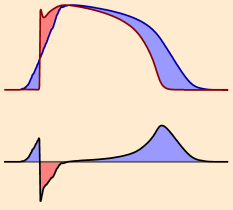Am. J. Physiol. Heart Circ. Physiol 297:792-801, August 2009.
links
doi:10.1152/ajpheart.00064.2009
abstract
Local unipolar electrograms (UEG) permit assessment of local activation and repolarization times at multiple sites simultaneously. However, UEG-based indices of local repolarization are still debated, in particular for positive T waves. Previous experimental and computer modeling studies have not been able to terminate the debate. In this study we validate a simple theoretical model of the UEG and use it to explain how repolarization statistics in the UEG relate to those in the action potential. The model reconstructs the UEG by taking the difference between an inverted local action potential and a position-independent "remote" signal. In normal tissue, this extremely simple model predicts T-wave morphology with surprising accuracy, while explaining in a readily understandable way why (1) the instant of repolarization is always related to the steepest upstroke of the UEG, both in positive and negative T waves, and (2) positive T waves are related to early-repolarizing sites whereas negative T waves are related to late-repolarizing sites.
funding
Computational resources for this work were provided by the
Réseau québécois de calcul de haute performance
(RQCHP).
This study was partially supported by the Netherlands Heart
Foundation, grant nr. 2005B092.
